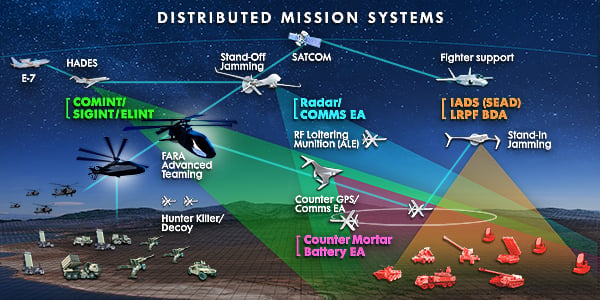
Distributed mission systems graphic courtesy of Northrop Grumman.
Joint All Domain Command and Control (JADC2) is usually described in terms of playing offense: the OODA loop, the kill chain, and sensors to effectors. Defense is inherent in the “C2” part of JADC2 but it’s not what comes to mind first.
To use a football analogy, it’s the quarterbacks that get the attention but it’s the teams with the best defense — against both the run and the pass — that usually make it to the championship.
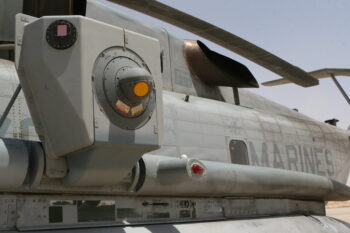
Large Aircraft Countermeasures (LAIRCM), one of Northrop Grumman’s IRCM systems, protects against infrared-guided missiles. It has been installed on more than 80 aircraft types. Shown above is a CH-53E installation. Photo courtesy of Northrop Grumman.
In the world of electronic warfare (EW), think of the electromagnetic spectrum as the playing field and the battle playing out upon it being waged both offensively through tactics such as targeting and spoofing and defensively through what’s known as countermeasures.
The military uses the electromagnetic spectrum — essential, yet invisible — to detect, deceive and disrupt the enemy while protecting friendly forces. As e
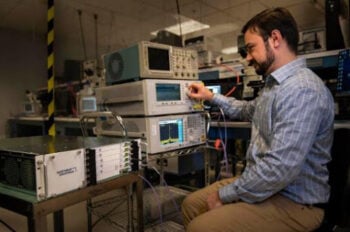
Northrop Grumman’s CEESIM faithfully simulates true-to-war conditions, providing radio frequency (RF) simulation of multiple, simultaneous emitters linked to static/dynamic platforms. Robust simulations of these advanced, near-peer threats offer the most affordable means of testing and validating effectiveness of sophisticated electronic warfare equipment. Photo courtesy of Northrop Grumman.
nemies become more capable and threats more complex, controlling the spectrum is increasingly critical.
“What has happened over the last few decades is that processing power has greatly increased,” explained Brent Toland, sector vice president and general manager for the navigation, targeting and survivability division, Northrop Grumman Mission Systems. “That allows one to create sensors where you can have increasingly broad, instantaneous bandwidth for much faster processing and greater awareness. Further, in a JADC2 context, this enables distributed mission solutions that are more effective and more resilient.”
Because the processing is all digital, signals can be adapted in real time at machine speeds. From the targeting side, that means that the radar signal can be adapted to make it harder to detect. From the countermeasures side, the response can also be adapted to better counter the threat.
Beating back the swarm with dynamic countermeasures
The new reality of electronic warfare is that greater processing ability makes the battlespace increasingly dynamic. For example, both the U.S. and its adversaries are developing concepts of operation for swarms of unmanned aerial systems that increasingly have sophisticated EW capabilities. In response, countermeasures must be equally advanced and dynamic.
“The swarm generally is performing some sort of sensor mission such as EW,” said Toland. “When there are multiple sensors flying on different air platforms and, perhaps, even space platforms, you are in an environment where you need to defend yourself against detection from multiple geometries.”
“It’s not just facing forward into an air defense system. All around you there are potential threats now. If they’re communicating with each other, then countermeasures also need to rely on multiple platforms to help commanders assess the situation and offer up effective solutions.”
Such a scenario is at the heart of JADC2, both offensively and defensively. An example of distributed systems conducting distributed EW missions would be a crewed Army platform with RF and IR countermeasures working in conjunction with an uncrewed Army platform with Air Launched Effects that is also performing some part of the RF countermeasures mission. This multi-ship, crewed-uncrewed configuration gives the commander multiple geometries in which to sense and defend than is possible when all the sensors are on a single platform.
“In an Army multi-domain-operations environment, you could readily see where they are absolutely going to need to have awareness all around themselves in terms of the threats that they will be immersed in,” said Toland.
It’s a capability that the Army, Navy, and Air Force all need for multispectral operations and electromagnetic spectrum dominance. That requires broader bandwidth sensors with advanced processing capabilities to control much larger swaths of spectrum.
Multispectral operations fuse data from multiple EW sensors
To conduct such multispectral operations, it will be essential to begin employing what’s known as mission-adapting sensors. Multispectral refers to the electromagnetic spectrum, including a range of frequencies that cover visible light, infrared radiation, and radio waves.
Targeting, for example, has historically been done with radars and electro-optical/infrared (EO/IR) systems. So multispectral in a targeting sense would be a system that can use broadband radar and multiple EO/IR sensors, such as digital color cameras and multi-band IR cameras. The system would have the ability to switch back and forth between the sensors to gather more data, by using different parts of the electromagnetic spectrum.
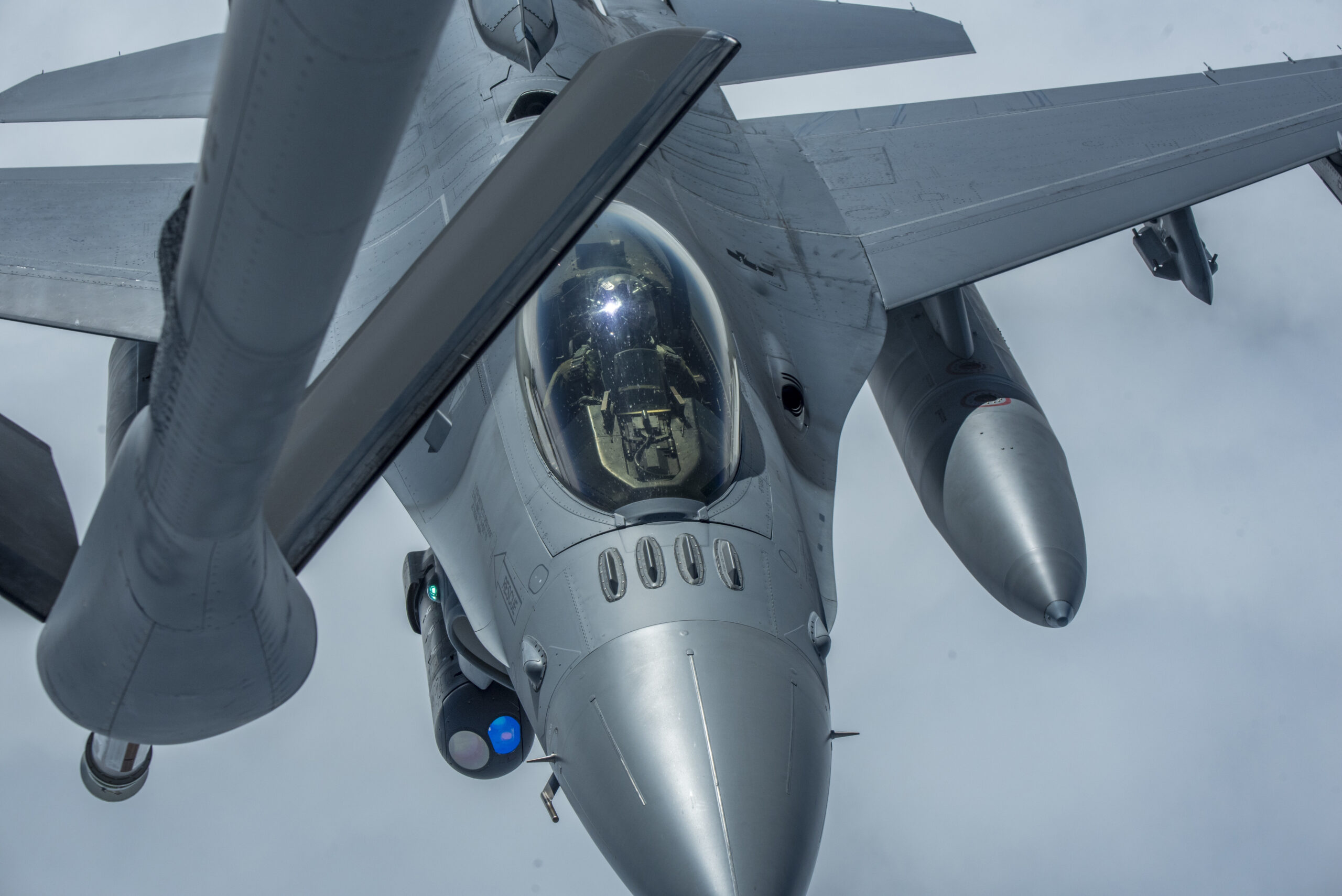
LITENING is an electro-optical/infrared targeting pod capable of imaging at long ranges and sharing data securely through its two-way, Plug-and-Play data links. U.S. Air National Guard photo by Staff Sgt. Bobbie Reynolds.
Also, multispectral doesn’t imply that a single targeting sensor has a combined capability in all areas of the spectrum, to use the example above. Rather, it is the use of two or more physically different systems, each sensing in its particular part of the spectrum, with the data being produced by each individual sensor fused together to produce a more accurate picture of the target.
Toland described the power of multispectral capabilities through the lens of countermeasures.
“On the survivability side, you’re obviously trying not to be detected or targeted. We have a long history of providing survivability in the infrared and radio frequency portions of the spectrum, with effective countermeasures for both.”
“You want to be able to detect if you are being acquired by an adversary in either portion of the spectrum, and then be able to provide the appropriate counter technique as needed — whether that be RF or IR. Multispectral becomes powerful here in the sense that you’re relying on both and can choose which is the appropriate part of the spectrum to use, as well as the appropriate techniques to counter the attack. You are assessing the information from both sensors and determining which is the most likely to protect you in this situation.”
Artificial intelligence (AI) plays an important role in fusing together and processing the data from two or more sensors for multispectral operations. AI helps to thin and sort the signals, culling out the signals of interest and providing an actionable recommendation of what the best course of action is.
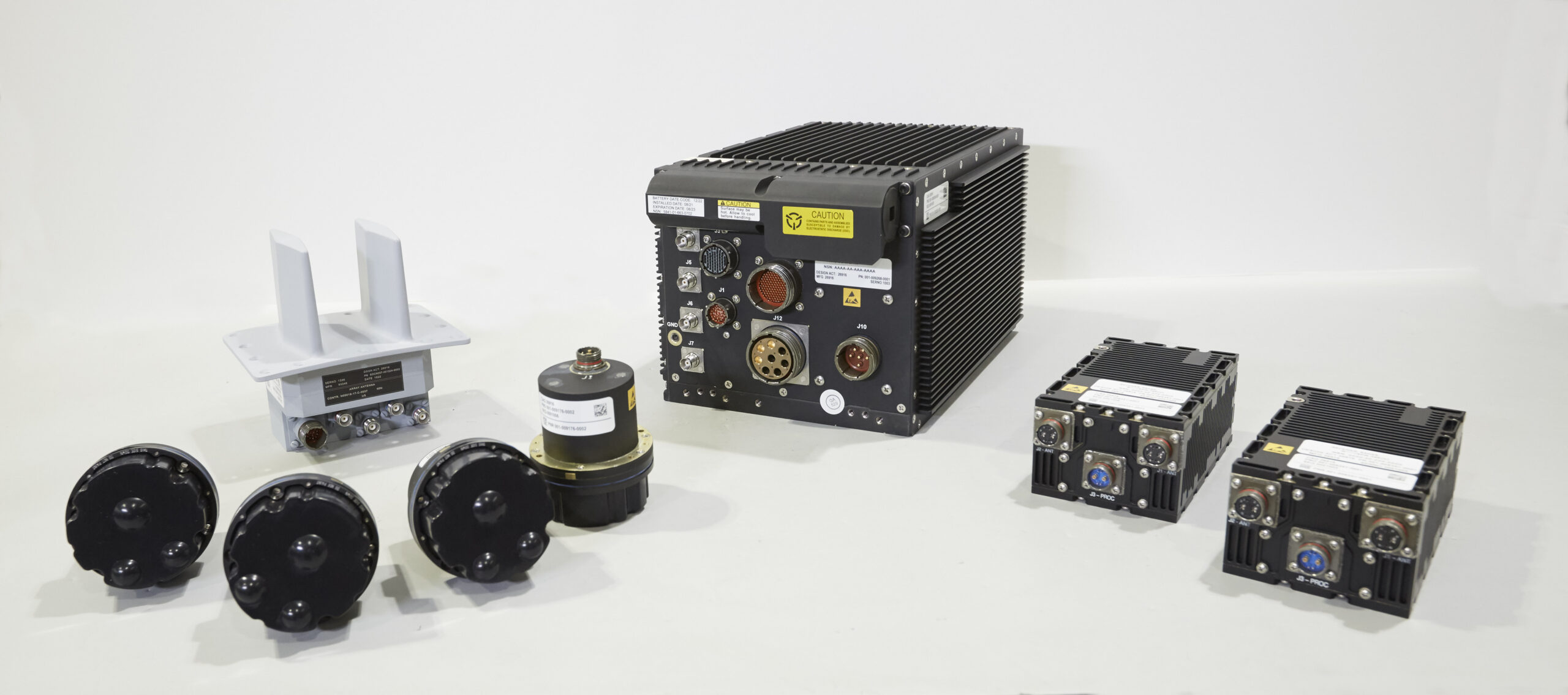
The AN/APR-39E(V)2 is the next step in the evolution of the AN/APR-39, the radar warning receiver and electronic warfare suite that has been protecting aircraft for decades. Its smart antenna detects agile threats over a wide frequency range, so there’s nowhere in the spectrum to hide. Photo courtesy of Northrop Grumman.
In a near-peer threat environment, there is going to be a proliferation of sensors and effectors, with many threats and signals coming at US and coalition forces. Presently, known EW threats are stored in a database of mission data files that identify their signatures. When an EW threat is detected, the database is searched at machine speed for that particular signature. When the stored reference is found the appropriate countermeasure techniques are applied.
It’s a certainty, however, that the US will face never-before-seen EW attacks (similar to Zero Day attacks in cybersecurity). This is where AI will step in.
“In the future, as the threats become more dynamic and change, and they are no longer able to be categorized, AI would be extremely helpful to identify what appears to be a threat that your mission data file would not recognize,” said Toland.
Conclusion
Multispectral operations and mission-adapting sensors are the response to a changing world where potential adversaries have well known and advanced capabilities in EW and cyber.
“The world is changing rapidly, and the shift of our defense posture toward near-peer competitors has heightened the urgency of us employing these new, multispectral systems in order to engage distributed systems and effects,” said Toland. “This is the near future of electronic warfare.”
Staying ahead in this era calls for fielding of a new generation of capabilities and enhancing the future of EW. Northrop Grumman’s expertise in electronic warfare, cyber, and electromagnetic maneuver warfare spans all domains — land, sea, air, space, cyberspace and the electromagnetic spectrum. The company’s multispectral, multifunction systems give warfighters superiority across the spectrum and allow for faster, more informed decisions and ultimately mission success.





















